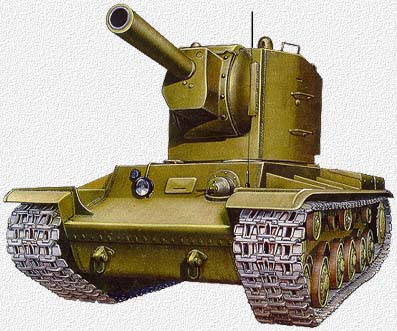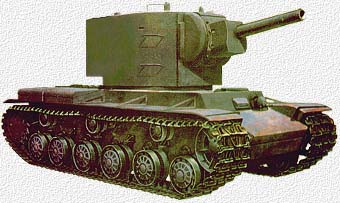| The KV-2 Heavy Assault Tank |
|---|
|
|

| The KV-2 Heavy Assault Tank |
|---|
|
|

On December 19, 1939, the KV-1 Heavy Tank was accepted for the service. At that time, the KV-1 took part in combat tests on the Russian-Finnish War (the Winter War). During those battles, the Soviet High Command come to conclusion that the heavy tank with more powerful armament is highly needed to combat with enemy's bunkers, pillboxes and other fortifications. The North-Western Front HQ ordered first four KV-1 tanks from experimental party must been armed with 152 mm howitzers. To do this, the best engineers from KTZ's design bureau were summoned. After two weeks a new project was completed. In a first time engineers decided use the 152 mm mod.1909/1930 howitzer, but later it was replaced with more modern 152 mm M-10 Howitzer Model 1938/1940. A new, bigger turret was designed to accept such heavy cannon. That turret was named "MT-1". At the beginning of 1941, the this tank was renamed to KV-2. Before this, the KV-1 called as "The Tank With a Small Turret", the KV-2 called as "The Tank With a Big Turret". The MT-1 turret was placed on the chassis of a twin-turret experimental tank instead of small turret (a large turret was also removed from the hull). On February 10, 1940, first trials were conducted. At the time, Soviet tank designers weren't very experienced in vehicles of such a heavy weight. They added a small lid on the the howitzer's barrel. That lid was intended to prevent a gun from the dust, shell's fragments and bullets. However, after the first shot this lid was torn away, after that it was never used. |
In 1940, a pair of KV-2 were sent to the battlefront on the Karelian isthmus. In spite of some rumors, KV-2s didn't take part in battles before the Great Patriotic War. The pair of KV-2 fired on already captured pillboxes. The results of those tests were excellent and later, in 1940, a KV-2 Heavy Tank was accepted for service. Soviet tankers often called those tanks as "Dreadnoughts". During the production, the tank's turret was slightly improved and additional DT Machine-Gun was mounted in it. The shortened M-10 Howitzer was able to fire a 52-kg high-explosive projectile with muzzle velocity of 436 m/s. Please notice, only high-explosive shells with reduced propellant charge were used for KV-2's gun. The naval semi-AP round model 1915/28 was alloed to be fired of KV-2, but that round used only in Red Navies and was absent in Red Army's warehouses. Despite some modern "sources", the usage of armor-piercing and anti-concrete ammunition was prohibited - it was recorded in the KV-2's operational manual. |
The KV-2 had 36 rounds for its main gun and 3087 rounds for its bow and rear machine-guns. The crew of six crewmembers: tank commander, gun commander, second gun commander (loader), gunner, driver, and radio operator. Besides of the 152-mm howtzer, there were some other guns which were either tested or intended to be mount on the KV-2. One of that was an attempt to mount a long barreled 106.7 mm Gun ZIS-6 (initially, this gun was proposed for the perspective KV-3 and KV-5 tanks). From May to June of 1941, the KV-2 with the ZIS-6 was tested on factory's trials, after that it was sent to the ANIOP's trials which it failed. Main problem was with gun's ammunition: the gun had single-loading rounds. Such a lond and heavy shells were wery hard to handle and operate by a single loader. |

Additionaly, the KV-2 armed with the 85 mm Gun F-39. Ordered by the NKO, in March 1941, the KV-2 with this gun was tested. Unfortunately, I was unable to find results of those tests.

Unfortunately, the new tank had same defects in transmission and chassis as the KV-1. Besides, most of KV-2 tanks didn't have a proper number of ammunition. Nevertheless, the appearance of KV-2 became a shock for German tankers. There wasn't any weapon, with the exception of the 88 mm AA-Gun, that could successfully defeat this beast.
 The KV-2 Tank from the 2nd Tank Division delayed the 6th Panzer Division near the Rossienie town. Tank was immobilized by the German's 105 mm Howitzer but continued fighting. It was abandoned when run out of ammo. |
Up north, the 6-Panzer-Division under Panzer-Gruppe 4 had encountered Russian heavy tanks. As related in the war diary of Panzer-Regiment 11 on 25 June 1941:
During the morning, the II.Abteilung/Panzer-Regiment 11 together with Kampfgruppe von Seckendorff advanced along the right-hand march route. Throughout the day both units fought off repeated attacks from the Russian 2nd Armored Division. Unfortunately, the Russian 52 ton heavy tanks showed that it was almost insensitive to hits from the 10.5-cm. Several hits from a 15-cm gun were ineffective and bounced off. However, continuous attacks by several Pz Kpfw lV managed to knock out a large number of tanks throughout the day, which allowed our own attack to again drive forward to about three kilometers west of Dubysa.
The bridgehead of Kampfgruppe Raus was held. During the afternoon, as a reserve, a reinforced company and the headquarters of Panzer-Abteilung 65 were pulled back along the left attack route to the crossroads northeast of Rossienie. In the meantime a Russian heavy tank had blocked the communications route to Kampfgruppe Raus, so that contact with Kampfgruppe Raus was broken for the entire afternoon and during the night. An 8.8-cm Flak battery was sent by the commander to fight this tank. It was just as unsuccessful as a 10.5-cm battery whose fire was directed by a forward observer. In addition, an attempt by a Pioneer assault troop using balled explosives failed. It was impossible to get close to the tank because of heavy machine gun fire.
The most of KV-2 tanks were lost because of breakdowns. For example, 41st Tank Division lost 22 KV-2 tanks of 33 tanks total. The only 5 tanks were destroyed by the enemy, other 17 tanks were abandoned because of breakdowns or run out of fuel.
In October 1941, the KV-2's manufacture was cancelled. Totally 334 KV-2 tanks were produced.

| REFERENCES: Specification of Soviet tanks Specifications of Soviet tank guns The Glossary of Soviet Terms and Abbreviations |
Sources:
"The KV-2 tank. Operational manual", Voenizdat, 1941; "M-Hobby" #5-6 1997 "Modelist-Constructor" #11 1984 V.Gagin "Heavy breakthrough tank Klim Virishilov" Poligraph 1996 "Bronekollektsiya" #1 1998 T.Jentz "Panzer Truppen", vol. 1; "Soviet heavy tanks in WWII", Tornado Cover picture - M.Dmitriev |